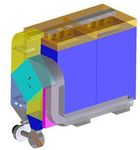3.1 Publishable summary - Energy Hub
←
→
Page content transcription
If your browser does not render page correctly, please read the page content below
3.1 Publishable summary Introduction and objectives To achieve low energy or even energy neutral districts, the share of renewable energy must increase drastically over present levels. Accommodating a large supplier of renewable energy, such as a large wind turbine, in the existing energy infrastructure is hampered by the fluctuating character of the energy supply. As a result, renewable energy supply is either too large or too small to cover the instantaneous energy demand. Both smart energy management systems and energy storage are essential to meet this challenge. The objective of the E‐hub project is to maximise the amount of renewable energy in a district by matching energy demand and supply, by shifting the demand of heat pumps, refrigerators or washing machines. Excess renewable heat can be stored in advanced Thermo‐Chemical Materials (TCM) or boreholes for prolonged periods with few heat losses. An important element is the acceptance of such an advanced energy system by energy suppliers and users alike. Therefore, developing new business models and service concepts that are attractive to all stakeholders is crucial. The E‐hub energy system will be demonstrated in the district of Tweewaters in Leuven, Belgium. In addition, four scenario studies will be carried out to assess the feasibility of an E‐hub type of system in the districts of Amsterdam (NL), Freiburg (D), Bergamo (It) and Dalian (China). Overview of the project and results obtained so far. WP1 on System Definition and WP2 on Energy Conversion & Storage have been finished in the first period. In the next phases of the project, we are using the results of these work packages, in particular the methodology for calculating the energy demand of a district, the methodology for determining the most suitable equipment for energy generation and distribution and the measurements on energy generating equipment such as CHP’s (Combined Heat and Power plants) based on an Internal combustion Engine (ICE) and a micro turbine. An overview of the remaining tasks in the E‐hub project is given in Figure 1 Figure 1: overview of the remaining tasks in the E‐hub project.
The pivotal work package is WP4 on Energy Management, where a Multi Commodity Matcher (MCM) algorithm was developed that allows to simultaneously match electricity and heat. First calculations show that the algorithm works as illustrated by Figure 2 (left) below. The MCM will be tested in a simulation environment that is being developed in Matlab. Where transfer of electrical energy from supplier to consumer can be considered (near) instantaneous and with minor energy losses, the transfer of heat must take place through piping, involving a delay between production and consumption and thermal losses. A first simple simulation model of a heating network was made; its results are illustrated in Figure 2 below. Figure 2: MCM providing solution lines (blue for electrical power and red for thermal power) (left) and still from a video demonstrating matching supply and demand of heat in a simple heating network with the colours indicating temperatures (right). A list was made of 18 components of which we need models in order to be able to carry out simulations of the MCM in a district. Among the components are a boiler, heat pump, CHP (Combined Heat and Power plant), thermal storage, among which thermo‐active foundations and solar road collector. Currently, models are available for approx. half of the items on the list. The models need to be able to communicate with the Energy Management System through a piece of software called an ’agent’. These need to be developed for all components. The simulation environment will be used to simulate the case studies of Amsterdam, Freiburg, Bergamo, Tweewaters and Dalian, allowing a virtual demonstration of the Energy Management System. Gathering of data for these districts is on‐going. The Energy Management System will also be demonstrated in practice in the lab demonstration at the laboratory of TPG and benchmarked against the ECoMP optimisation software from TPG. Preparatory tests are being carried out at the TPG lab on pieces of equipment in combination with thermal storage. Oscillations were found to occur in thermal output (Figure 3) that are attributed to sudden changes in the measured water temperatures inside the storage vessel, leading to misinformation on the SoC (State of Charge). Since VITO is working on the same subject (see below), TPG and VITO decided to share information on the topic.
Figure 3: Equipment at the lab at TPG and oscillations in thermal and electrical power output WP6 on business models will supply business models /service models to allow specific optimisations for the Energy Management System. For instance, the system could minimise the energy bill for the benefit of end users or shave peaks or reduce imbalance for the benefit of the DSO (Distribution System Operator). The business models need to be translated into so‐called ‘business agents’ allowing interaction with the Energy Management System. In the first stage of WP6, a description was made of market needs and business models in Deliverable 6.1 through a literature study, 20 case studies of energy efficiency projects and a web questionnaire. Currently, the effort is focussing on the interaction between energy efficiency projects and investors. A literature review will be conducted as well as interviews with financial experts at ISPE. The results will be discussed in workshops with relevant stakeholders such as builders, utilities and investors. Work is also progressing on the identification of new business models, tailored to new energy management systems, such as the MCM. Thermal storage, developed in WP3 is an important component in the matching of supply and demand of thermal energy. Thermo‐active foundations are being developed as low temperature heat storage. They can be combined with thermal road collector to restore the heat balance of the soil over a summer+ winter period. In the work on thermo‐active foundations, a number of promising innovations, such as the use of thermally enhanced concrete have been analysed, using calibrated high detail 3D‐FEM models. The work on the optimisations of the thermal road collector aims to increase the temperature level of the water at the exit, e.g. by minimising the depth of the pipes in the asphalt without compromising the structural stability of the road. Figure 4: High detail 3D‐FEM models of thermo‐active foundations (left) and finite elements model of pipes in asphalt (right).
Thermal storage components based on Thermo Chemical Materials (TCM’s) are being developed by TNO and ECN while distributed thermal storage is carried out by VITO, as illustrated in Figure 5. Figure 5: Draft 3D visualisation of the ECN 14 kWh reactor (left), artist impression of the TNO 3 kWh reactor (middle) and picture of the test rig in the lab of VITO (right). VITO is also carrying out a study to accurately determine the State of Charge (SoC) of a water based storage vessel with a minimum number of temperature sensors. As mentioned previously, TPG is particularly interested as they are facing a similar problem. In WP5 Demonstration, the energy management system will be applied in a real demonstration at the district of Tweewaters. A first, conservative estimate of the financial benefits of this ‘smart’ energy system amounts to approx. 100 €/household/year or approx. 10% of the energy bill. The construction of the building ‘Balk van Beel’ is progressing as planned as shown in Figure 6 below. Ertzberg is proud to announce that this building has been awarded the BREEAM certificate ‘Outstanding’, the first building on the mainland of Europe to achieve this. Figure 6: Pictures of the construction process on the ‘Balk van Beel’ in May 2012 (left) and November 2012 (right). In the period between mid 2013 and mid 2014, real time metering will commence on dwelling & building level (1 min scan), collaboration with end users on the User Interface and installation of demand response appliances such as white goods. Installation of the biomass fired CHP, heating network and possibly thermal storage will start in mid 2014.
The electricity part of the energy management system is certain to be implemented, while implementation of the full Multi Commodity Matcher depends on the progress within the project, although provisions are made at Tweewaters to accommodate it. In WP7 Dissemination, a website was made (http://www.e‐hub.org/), containing a public part as well as a restricted part, the latter serving as a database for all project related documents. The website is regularly updated. Figure 7: Home page of the public part of the website. It the first two years of the project, nine scientific papers were submitted for presentations at (future) national and international conferences, and nine lectures were given on the demonstration project in Tweewaters. ECN hosted and co‐organised an expert meeting in IEA task/annex 42/24 “compact heat storage”. A peer review procedure was installed to ensure a consistently high quality of deliverables, described in an extra Deliverable. Impact Due to finite stocks of fossil fuels and an increasing demand for energy, energy prices are expected to rise in the future. Considering also increasing public awareness of the effects of greenhouse gas emissions and stricter regulation on the matter, future energy supply systems are expected to change considerably. The share of renewable energy from wind, biomass and solar energy will grow substantially. Application of energy buffers and intelligent energy management systems are essential to match demand and supply of energy to deal with the fluctuating nature of renewable energy supply. Energy, being an increasingly scarce commodity, is expected to be subject to a price differentiation, replacing the flat rate in use today. Energy will be more expensive in times of shortage of supply and cheaper in times of abundant supply. Powermatcher ® and similar software to be developed in the E‐hub project already use a pricing mechanism ‐ presently using artificial prices ‐ to match the supply and demand of energy. This system therefore is well prepared for future price differentiation. More information can be found on the project website: http://www.e‐hub.org/
You can also read



























































